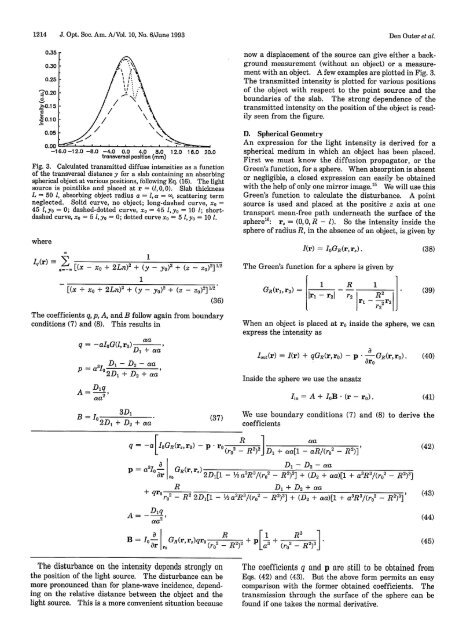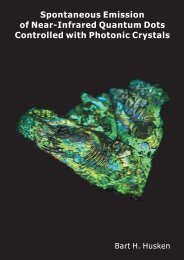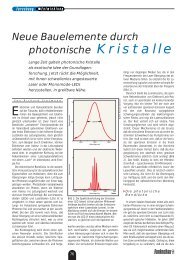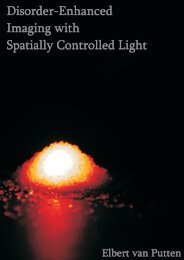Location of objects in multiple-scattering media - COPS
Location of objects in multiple-scattering media - COPS
Location of objects in multiple-scattering media - COPS
You also want an ePaper? Increase the reach of your titles
YUMPU automatically turns print PDFs into web optimized ePapers that Google loves.
1214 J. Opt. Soc. Am. A/Vol. 10, No. 6/June 1993<br />
0.35<br />
0.30<br />
0.25<br />
,0.20 /<br />
.10.10/ Z005 . /X ll<br />
0.05<br />
0.00 -<br />
-1 6.0 -12.0 -8.0 -4.0 0.0 4.0 8.0 12.0 1 6.0 20.0<br />
transversal position (mm)<br />
Fig. 3. Calculated transmitted diffuse <strong>in</strong>tensities as a function<br />
<strong>of</strong> the transversal distance y for a slab conta<strong>in</strong><strong>in</strong>g an absorb<strong>in</strong>g<br />
spherical object at various positions, follow<strong>in</strong>g Eq. (16). The light<br />
source is po<strong>in</strong>tlike and placed at r= (1,0,0). Slab thickness<br />
L = 50 1, absorb<strong>in</strong>g object radius a = , = , scatter<strong>in</strong>g term<br />
neglected. Solid curve, no object; long-dashed curve, x =<br />
45 ,yo = 0; dashed-dotted curve, x = 45 ,yo = 10 1; shortdashed<br />
curve, xo = 5 1, yo = 0; dotted curve x 0 = 5 1, yo = 10 1.<br />
where<br />
nIr [(x - xo + 2Ln) 2 + (y - yo) 2 + (z - Z2]12<br />
1<br />
[(x + x 0 + 2Ln) 2 + (y - yo) 2 + (Z - ZO)2]112<br />
(36)<br />
The coefficients q, p, A, and B follow aga<strong>in</strong> from boundary<br />
conditions (7) and (8). This results <strong>in</strong><br />
q = -aIOG(, rO) aa'<br />
D + aa<br />
= D - D2- a<br />
a 3 IO 2 D + D 2 + a<br />
A =Dq<br />
aa2<br />
B = + 3D+ D1<br />
2,+ D2 + aa~<br />
q = -a[IoGR(rsrO) - p ro<br />
p = a 3 I 0a- GR(r, r)2<br />
A = _ Dlq<br />
aa2<br />
The disturbance on the <strong>in</strong>tensity depends strongly on<br />
the position <strong>of</strong> the light source. The disturbance can be<br />
more pronounced than for plane-wave <strong>in</strong>cidence, depend<strong>in</strong>g<br />
on the relative distance between the object and the<br />
light source. This is a more convenient situation because<br />
now a displacement <strong>of</strong> the source can give either a background<br />
measurement (without an object) or a measurement<br />
with an object. A few examples are plotted <strong>in</strong> Fig. 3.<br />
The transmitted <strong>in</strong>tensity is plotted for various positions<br />
<strong>of</strong> the object with respect to the po<strong>in</strong>t source and the<br />
boundaries <strong>of</strong> the slab. The strong dependence <strong>of</strong> the<br />
transmitted <strong>in</strong>tensity on the position <strong>of</strong> the object is readily<br />
seen from the figure.<br />
D. Spherical Geometry<br />
An expression for the light <strong>in</strong>tensity is derived for a<br />
spherical medium <strong>in</strong> which an object has been placed.<br />
First we must know the diffusion propagator, or the<br />
Green's function, for a sphere. When absorption is absent<br />
or negligible, a closed expression can easily be obta<strong>in</strong>ed<br />
with the help <strong>of</strong> only one mirror image. 5 We will use this<br />
Green's function to calculate the disturbance. A po<strong>in</strong>t<br />
source is used and placed at the positive z axis at one<br />
transport mean-free path underneath the surface <strong>of</strong> the<br />
sphere' 6 : r, = (O,O,R - ). So the <strong>in</strong>tensity <strong>in</strong>side the<br />
sphere <strong>of</strong> radius R, <strong>in</strong> the absence <strong>of</strong> an object, is given by<br />
I(r) = IGR(r,r). (38)<br />
The Green's function for a sphere is given by<br />
1<br />
GR (rl,r 2) = I 2<br />
R 1<br />
r2 R2<br />
ri - _X`2<br />
r22<br />
(39)<br />
When an object is placed at r <strong>in</strong>side the sphere, we can<br />
express the <strong>in</strong>tensity as<br />
Iout(r) = I(r) + qGR(r,ro) - P a GR(rro).<br />
aro<br />
Inside the sphere we use the ansatz<br />
(40)<br />
I<strong>in</strong> = A + IoB (r - r). (41)<br />
We use boundary conditions (7) and (8) to derive the<br />
coefficients<br />
R 1 cia<br />
2 (r0 - R2)2J Di + aa[l 2 - 2 aR/(rb - R )]<br />
D- -D2-aa<br />
al. ro 2D,[1 - /2 a3R3 2 /(r0 -<br />
2 3 R ) ] + (D2 + aa)[1 + a 3 R3/(r 2 R<br />
-R2)3]<br />
+qor2- R 22DJ[1 - /2 a R 3 /(ro 2<br />
a R [I R 3<br />
ar ro (ro2 i) 3+(<br />
0 2 -R23<br />
D, + D 2 + aa<br />
- R 2 ) 3 ] + (D 2 + aa)[1 + a3R 3 /(ro 2 - R2)3]<br />
Den Outer et al.<br />
(42)<br />
(43)<br />
(44)<br />
(45)<br />
The coefficients q and p are still to be obta<strong>in</strong>ed from<br />
Eqs. (42) and (43). But the above form permits an easy<br />
comparison with the former obta<strong>in</strong>ed coefficients. The<br />
transmission through the surface <strong>of</strong> the sphere can be<br />
found if one takes the normal derivative.









